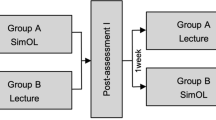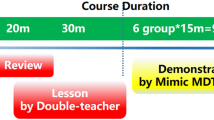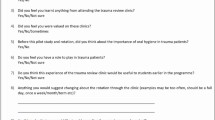Abstract
Oral pathology is a critical component of dental education, yet the complexity and breadth of the subject often leads to fragmented learning. This can hinder a student's ability to effectively diagnose and manage common oral lesions. This study aimed to apply the ‘scholarship of teaching and learning' (SoTL) to enhance the oral pathology curriculum, focusing on the differential diagnosis process to improve student competence and patient care. We introduced oral pathology rosters: small-group, case-based sessions where Year 3 dental students analysed clinical cases and practised diagnostic skills. The SoTL 4M framework (micro, meso, macro, mega) guided the evaluation of teaching practices, focusing on classroom dynamics (micro), curriculum structure (meso), institutional factors (macro) and the national and international context (mega). Student feedback and measurable outcomes were assessed. Rosters significantly improved student engagement, diagnostic competence and confidence. Students appreciated the interactive format and immediate feedback, which deepened their understanding and application of diagnostic principles. Survey responses indicated significantly increased retention and ability to apply knowledge in clinical settings. Applying SoTL to the oral pathology curriculum successfully bridged the gap between theory and practice, enhancing students' preparedness for real-world clinical scenarios. This approach not only improved learning outcomes but also supported better patient care through earlier diagnosis of oral lesions.
Key points
-
The study demonstrates how small-group learning sessions significantly enhance a student's ability to diagnose oral lesions, leading to more accurate and timely identification of dental conditions.
-
By incorporating interactive, case-based learning, the findings highlight a method that boosts student interest and involvement, making dental education more enjoyable and effective.
-
The approach bridges the gap between theoretical knowledge and clinical practice, equipping students with practical skills essential for real-world scenarios in private dental practice.
-
The application of scholarship of teaching and learning principles provides a replicable framework for enhancing dental curricula, fostering continuous improvement and modernisation in dental education.
This is a preview of subscription content, access via your institution
Access options
Subscribe to this journal
Receive 24 print issues and online access
$259.00 per year
only $10.79 per issue
Buy this article
- Purchase on SpringerLink
- Instant access to full article PDF
Prices may be subject to local taxes which are calculated during checkout

Similar content being viewed by others
Data availability
Raw data for Figure 1 are not publicly available due to licensing agreements and cannot be distributed beyond the institution where this study was conducted.
References
Woo S-B. Oral Pathology. 3rd ed. Philadelphia: Elsevier, 2023.
Felten P. Principles of good practice in SoTL. Teach Learn Inq 2013; 1: 121-125.
Hamilton M, Collum B. Moving From ‘good' to ‘great' SoTL: the importance of describing your research epistemological and ontological traditions in your SoTL scholarship. Teach Learn Inq 2024; 12: 1-15.
Friberg J. Might the 4M framework support SoTL advocacy? 2016. Available at https://illinoisstateuniversitysotl.wordpress.com/2016/07/11/might-the-4m-framework-support-sotl-advocacy/#comments (accessed July 2025).
Simmons N. Synthesizing SoTL institutional initiatives toward national impact. New Dir Teach Learn 2016; 146: 95-102.
Idrees M, Halimi R, Gadiraju S, Frydrych A M, Kujan O. Clinical competency of dental health professionals and students in diagnosing oral mucosal lesions. Oral Dis 2023; 30: 3108-3116.
Forman M S, Chuang S-K, August M. The accuracy of clinical diagnosis of oral lesions and patient-specific risk factors that affect diagnosis. J Oral Maxillofac Surg 2015; 73: 1932-1937.
Sbricoli L, Zago R, Cavallin F, Stellini E, Bacci C. Diagnostic ability in oral pathology among different population clusters. Oral Dis 2023; 30: 2278-2284.
Ganatra S, Doblanko T, Rasmussen K et al. Perceived effectiveness and applicability of think-pair-share including storytelling (TPS-S) to enhance clinical learning. Teach Learn Med 2021; 33: 184-195.
Gianoni-Capenakas S, Lagravere M, Pacheco-Pereira C, Yacyshyn J. Effectiveness and perceptions of flipped learning model in dental education: a systematic review. J Dent Educ 2019; 83: 935-945.
Kassebaum D K, Tedesco L A. The 21(st)-century dental curriculum: a framework for understanding current models. J Dent Educ 2017; DOI: 10.21815/JDE.017.002.
Perez A, Arntson C, Howey M, Amin M, Kebbe M, Ganatra S. Dental students' perceptions of the wildcard as a novel teaching technique in case-based learning. J Dent Educ 2022; 86: 1350-1358.
Gordy X Z, Zhang L, Sullivan A L, Bailey J H, Carr E O. Teaching and learning in an active learning classroom: a mixed-methods empirical cohort study of dental hygiene students. J Dent Educ 2019; 83: 342-350.
Rodis O M M, Locsin R C. The implementation of the Japanese Dental English core curriculum: active learning based on peer-teaching and learning activities. BMC Med Educ 2019; 19: 256.
Lin K-Y. Two-tier instant-feedback assessment strategy for improvement of student concentration. Comput Inform Nurs 2022; 40: 447-454.
Potter M K. The relationship between scholarly teaching and SoTL: models, distinctions, and clarifications. Int J Scholarsh Teach Learn 2011; 5: 1-18.
Acknowledgments
The authors would like to thank Dr. Maria Copete for her valuable contributions to the field and education of Oral Pathology
Funding
Grant holders: FS is supported by Royal University Hospital Foundation grant 106858 and Saskatchewan Health Research Foundation grant 6539.
Author information
Authors and Affiliations
Contributions
LW wrote the initial draft of the manuscript. MH, WS, and FS contributed to the design of the research. MH and FS implemented the research, conducted the analysis of the results and the writing of the manuscript. FS was responsible for the final editing of the manuscript.
Corresponding author
Ethics declarations
The authors declare that they have no competing interests. Ethical approval was not required as per the Tri-Council Policy Statement: Ethical Conduct for Research Involving Humans - TCPS 2 (2022): ‘Research ethical board review is not required for research that relies exclusively on secondary use of anonymous information, or anonymous human biological materials, so long as the process of data linkage or recording or dissemination of results does not generate identifiable information'. Participants provided their consent to take part in the validated survey administered in this study.
Rights and permissions
Springer Nature or its licensor (e.g. a society or other partner) holds exclusive rights to this article under a publishing agreement with the author(s) or other rightsholder(s); author self-archiving of the accepted manuscript version of this article is solely governed by the terms of such publishing agreement and applicable law.
About this article
Cite this article
Hamilton, M., Wandzura, L., Siqueira, W. et al. A scholarship of teaching and learning approach for the oral pathology dental curriculum. Br Dent J 239, 274–278 (2025). https://doi.org/10.1038/s41415-025-8718-z
Received:
Revised:
Accepted:
Published:
Issue date:
DOI: https://doi.org/10.1038/s41415-025-8718-z



